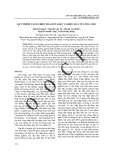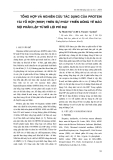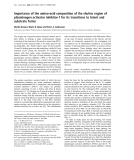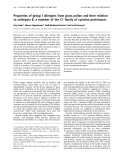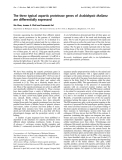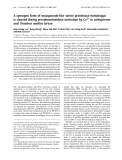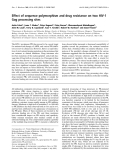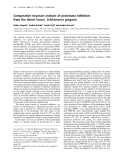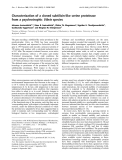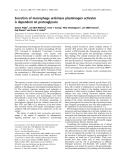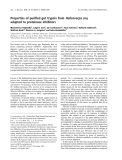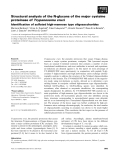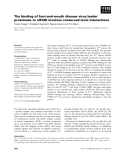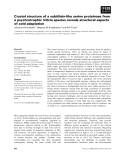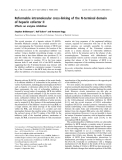
Proteinase
-
Luận văn được thực hiện với mục tiêu nhằm: mô tả đặc điểm của ệnh phổi tắc nghẽn mạn tính điều trị tại Bệnh viện A Thái Nguyên. Mô tả một số biểu hiện bệnh lý tim mạch và xác định mối liên quan biểu hiện bệnh lý tim mạch với một số đặc điểm lâm sàng, cận lâm sàng bệnh nhân bệnh phổi tắc nghẽn mạn tính. Mời các bạn cùng tham khảo.
 87p
87p  xiaojingteng
xiaojingteng
 24-06-2021
24-06-2021
 19
19
 3
3
 Download
Download
-
Bài viết tập trung nghiên cứu sử dụng phương pháp điện di xác định hoạt tính enzyme trên gel polyacrylamide có bổ sung cơ chất gelatin để phân tích hoạt tính của enzyme gelatinase (gồm MMP-2, MMP-9 và các dạng tiền hoạt động của chúng) nhằm tìm hiểu mối liên quan giữa các MMP đó với một số đặc điểm bệnh học của một nhóm bệnh nhân UTĐTT ở Việt Nam.
 11p
11p  jangni2
jangni2
 19-04-2018
19-04-2018
 64
64
 4
4
 Download
Download
-
Bài viết trình bày về quy trình tách chiết DNA đơn giản và hiệu quả từ lông chó. Phần gốc lông chó (khoảng 1 cm) được ủ trong dung dịch đệm chiết có bổ sung proteinase K ở nhiệt độ 50ºC trong 60 phút để phá vỡ màng tế bào. DNA được giải phóng sẽ được tách ra khỏi các thành phần khác của tế bào bằng hỗn hợp phenol + chloroform và được tủa bằng ethanol lạnh. Sau đó DNA thu được sẽ được hòa tan trong nước và được lưu giữ ở nhiệt độ -30ºC.
 9p
9p  jangni
jangni
 16-04-2018
16-04-2018
 85
85
 4
4
 Download
Download
-
Đề tài thực hiện nhằm chuẩn hóa phương pháp ly trích ADN từ mô thận của cá tra theo phương pháp của Taggart et al. (1992) và tối ưu hóa phương pháp PCR phát hiện E. ictaluri. Qui trình ly trích ADN được chuẩn hóa có thời gian thực hiện bằng 1/8 lần qui trình gốc (Taggart et al, 1992) với hàm lượng Proteinase K sử dụng là 2.5µl (40mg/ml), thời gian ủ ở bước 1 là 15 phút; hàm lượng RNase là 2.5µl (2mg/ml), thời gian ủ bước 2 là 30 phút. Qua thí nghiệm xác định được độ...
 53p
53p  bandoctl
bandoctl
 01-07-2013
01-07-2013
 138
138
 26
26
 Download
Download
-
Heparan sulfate proteoglycans (HSPG) nằm ở trên bề mặt tế bào hoặc trong khoảng gian bào của tất cả các mô động vật. HSPG và các protein liên kết với chúng tham gia vào nhiều quá trình sinh học của tế bào như: sự liên kết tế bào - tế bào, quá trình phân bào, biệt hóa, sự di chuyển và các quá trình sinh bệnh lý của tế bào [1, 2, 6]. Khoảng gian bào là nơi lưu giữ và giải phóng các enzyme proteinase, các chất ức chế và các yếu tố phát triển tế bào. Những tác nhân gây ra sự giải phóng các yếu tố...
 7p
7p  sunshine_3
sunshine_3
 28-06-2013
28-06-2013
 32
32
 3
3
 Download
Download
-
The serpins are of general protein chemical interest due to their ability to undergo a large conformational change consisting of the insertion of the reactive centre loop (RCL) as strand 4 of the central b sheet A. To make space for the incoming RCL, the ‘shutter region’ opens by the b strands 3A and 5A sliding apart over the underlying a helix B. Loop insertion occurs during the formation of complexes of serpins with their target serine proteinases and during latency transition. This type of loop insertion is unique to plasminogen activator inhibitor-1 (PAI-1).
 10p
10p  system191
system191
 01-06-2013
01-06-2013
 41
41
 4
4
 Download
Download
-
Expansins are a family of proteins that catalyze pHdependent long-term extension of isolated plant cell walls. They are divided into two groups, a and b, the latter consisting of the grass group I pollen allergens and their vegetative homologs. Expansins are suggested to mediate plant cell growth by interfering with either structural proteins or the polysaccharide network in the cell wall.
 10p
10p  research12
research12
 01-06-2013
01-06-2013
 28
28
 4
4
 Download
Download
-
The diseaseFusarium head blight (scab) causes severe problems for farmers and for the industries that use cereals. It is likely that the fungi that cause scab (Fusariumspp.) use various enzymes when they invade grains. We are studying enzymes that the fungi may use to hydrolyze grain proteins. To do this,Fusarium culmorumwas grown in a gluten-con-taining medium from which an alkaline serine proteinase with a molecular mass of 28.7 kDa was puri®ed by size-exclusion and cation exchange chromatographies....
 10p
10p  research12
research12
 01-06-2013
01-06-2013
 54
54
 5
5
 Download
Download
-
Genomic sequencing has identified three different typical plant aspartic proteinases in the genome ofArabidopsis thaliana, named Pasp-A1, A2 and A3. A1 is identical to a cDNA we had previously isolated and the two others pro-duceproteins 81and63%identical to that predictedprotein. Sequencing of the aspartic proteinase protein purified from Arabidopsisseeds showed that the peptides are derived from two of these genes, A1 and A2.
 10p
10p  research12
research12
 23-04-2013
23-04-2013
 32
32
 1
1
 Download
Download
-
To elucidate the biochemical activation mechanism of the insect pro-phenoloxidase (pro-PO) system, we purified a 45-kDa protein to homogeneity from the hemolymph of Tenebrio molitor(mealworm) larvae, and cloned its cDNA. The overall structure of the 45-kDa protein is similar to Drosophilamasquerade serine proteinase homologue, which isanessential component inDrosophilamuscledevelopment.
 9p
9p  research12
research12
 23-04-2013
23-04-2013
 27
27
 2
2
 Download
Download
-
The HIV-1 proteinase (PR) has proved to be a good target for antiretroviral therapy of AIDS, and various PR inhibi-tors are now in clinical use. However, there is a rapid selec-tionof viral variantsbearingmutations in theproteinase that are resistant to clinical inhibitors. Drug resistance also involves mutations of the nucleocapsid/p1 and p1/p6 clea-vage sites ofGag, bothin vitroandin vivo.
 7p
7p  research12
research12
 23-04-2013
23-04-2013
 37
37
 2
2
 Download
Download
-
The solution structure of three small serine proteinase inhibitors, two natural and one engineered protein, SGCI (Schistocerca gregaria chymotrypsin inhibitor), SGCI[L30R, K31M] and SGTI (Schistocerca gregaria trypsin inhibitor), were determined by homonuclear NMR-spectroscopy. The molecules exhibit dierent speci®cities towards target proteinases, where SGCI is a good chymo-trypsin inhibitor, itsmutant is apotent trypsin inhibitor, and SGTI inhibits both proteinases weakly.
 11p
11p  research12
research12
 23-04-2013
23-04-2013
 33
33
 2
2
 Download
Download
-
The gene encoding a subtilisin-like serine proteinase in the psychrotrophic Vibriosp. PA44 has been successfully cloned, sequenced and expressed in Escherichia coli.The gene is 1593 basepairs and encodes a precursor protein of 530 amino acid residues with a calculated molecular mass of 55.7 kDa. The enzyme is isolated, however, as an active 40.6-kDa proteinase, without a 139amino acid residue N-terminal prosequence.
 11p
11p  tumor12
tumor12
 22-04-2013
22-04-2013
 51
51
 2
2
 Download
Download
-
The importance of proteoglycans for secretionof proteolytic enzymes was studied in the murine macrophage cell line J774. Untreated or 4b-phorbol 12-myristate 13-acetate (PMA)-stimulated macrophages were treated with hexyl-b-D-thioxyloside to interfere with the attachment of glycosaminoglycan chains to their respective protein cores. Activation of the J774 macrophages with PMA resulted in increased secretion of trypsin-like serine proteinase activity.
 10p
10p  tumor12
tumor12
 20-04-2013
20-04-2013
 34
34
 3
3
 Download
Download
-
Pest insects such asHelicoverpaspp. frequently feed on plants expressing protease inhibitors. Apparently, their digestive system can adapt to the presence of protease inhibitors. To study this, a trypsin enzymewas purified from the gut of insects that were raised on an inhibitor-containing diet. The amino-acid sequence of this enzyme was analysed by tandem MS, which allowed assignment of 66% of the mature protein amino acid sequence. This trypsin, called HzTrypsin-S, corresponded to a known cDNA sequence fromHelicoverpa. ...
 10p
10p  tumor12
tumor12
 20-04-2013
20-04-2013
 26
26
 3
3
 Download
Download
-
Plasminogen activator inhibitor-1 (PAI-1) belongs to the serpin family of serine proteinase inhibitors. Serpins inhibit their target proteinases by an ester bond being formed between the active site serine of the proteinase and the P1 residue of the reactive centre loop (RCL) of the serpin, fol-lowed by insertion of the RCL intob-sheet A of the serpin. Concomitantly, there are conformational changes in the flexible joint region lateral tob-sheet A.
 8p
8p  fptmusic
fptmusic
 16-04-2013
16-04-2013
 28
28
 2
2
 Download
Download
-
Trypanosoma cruzi, the parasitic protozoan that causes Chagas disease, contains a major cysteine proteinase, cruzipain. This lysosomal enzyme bears an unusual C-terminal extension that contains a number of post-translational modifications, and most antibodies in natural and experimen-tal infections are directed against it. In this report we took advantage of UV-MALDI-TOF mass spectrometry in conjunction with peptide N-gly-cosidase F deglycosylation and high performance anion exchange chroma-tography analysis to address the structure of the N-linked oligosaccharides present in this domain. ...
 13p
13p  fptmusic
fptmusic
 11-04-2013
11-04-2013
 42
42
 2
2
 Download
Download
-
The leader proteinase (L pro ) of foot-and-mouth disease virus (FMDV) ini-tially cleaves itself from the polyprotein. Subsequently, L pro cleaves the host proteins eukaryotic initiation factor (eIF) 4GI and 4GII. This prevents protein synthesis from capped cellular mRNAs; the viral RNA is still trans-lated, initiating from an internal ribosome entry site. L pro cleaves eIF4GI between residues G674 and R675. We showed previously, however, that L pro binds to residues 640–669 of eIF4GI.
 10p
10p  awards
awards
 06-04-2013
06-04-2013
 36
36
 4
4
 Download
Download
-
The crystal structure of a subtilisin-like serine proteinase from the psychro-trophic marine bacterium, Vibriosp. PA-44, was solved by means of molecular replacement and refined at 1.84 A˚ . This is the first structure of a cold-adapted subtilase to be determined and its elucidation facilitates examination of the molecular principles underlying temperature adaptation in enzymes.
 14p
14p  awards
awards
 05-04-2013
05-04-2013
 37
37
 1
1
 Download
Download
-
The crystal structure of a heparin cofactor II (HCII)– thrombin Michaelis complex has revealed extensive con-tacts encompassing the N-terminal domain of HCII and exosite I of the proteinase. In contrast, the location of the N-terminal extension in the uncomplexed inhibitor was unclear.
 9p
9p  awards
awards
 05-04-2013
05-04-2013
 38
38
 5
5
 Download
Download
CHỦ ĐỀ BẠN MUỐN TÌM










